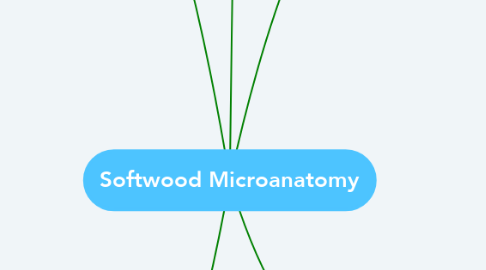
1. RAYS
1.1. Fusiform Rays
1.2. Containing a resin canal
1.3. Occur in all species that have longitudinal resin canals
1.4. Consist of (i) Ray Tracheids (ii) Ray Parenchyma (iii) Epithelial Cells
1.5. Conifer Rays
1.5.1. Horizontal orientation
1.5.2. Composed of ray tracheids and ray parenchyma
1.6. Heterocellular Rays
1.7. Dentation
1.7.1. Occur in ray tracheids of hard pines
1.7.2. Dentate ray tracheids - cell wall thickenings around pits
2. PITS
2.1. 3 types pf pits : (i) Simple (ii) Bordered (iii) Half-bordered
2.1.1. Allow transportation of fuilds between cells
2.1.2. All pits have pit cavity and pit membrane components
2.1.3. All appear on radial surface
2.2. Simple pit - the cavity is nearly constant in width.
2.3. Bordered pit - the cavity narrows towards the cell lumen typically, the membrane is arched over by the secondary cell wall
2.4. Half-bordered pit occur between ray parenchyma and longitudinal tracheids
2.5. Cross-field Pits
2.5.1. Pits that connect ray parenchyma to longitudinal tracheids
2.5.2. One of the most useful microscopic features for softwood identification
2.5.3. Shape, size, and number of pits per cross-field vary from one softwood type to another.
2.5.4. 5 types of cross-field : (i) window-like (ii) pinoid (iii) cupressoid (iv) piceoid (v) taxodioid
2.6. Aspiration / lateral displacement of the membrane
2.6.1. A modification of bordered pit-pairs
2.6.2. Take places when sapwood is transformed into heartwood or when wood dries
2.6.3. The torus seals one of the pit apertures which blocks the passage through the pit
2.6.4. Impact to wood of Spruces, Douglas fir hard to impregnate with preservatives
3. TRACHEID
3.1. Conduct water/solutes and provide mechanical support
3.2. 90-95% of wood (xylem) volume
3.3. Occur in radial rows
3.4. Longitudinal Tracheid
3.4.1. Spiral / Helical Thickening - on inner cell wall
3.4.2. Elongated cells with thickened walls and tapering, pointed ends
3.4.3. Side walls of tracheids contain pits.
3.4.4. Radial diameter decreases from earlywood to latewood
4. PARENCHYMA
4.1. Conduct and store foods and other substances
4.2. Epithelial Cells
4.2.1. Excrete resin and form the periphery of a structure called resin canal
4.3. Longitudinal / Strand Parenchyma
4.3.1. Formed by fusiform cambial initials
4.3.2. Relatively thin-walled cells
4.3.3. May contain darkly staining substances
5. RESIN CANAL
5.1. Assist in wood identification
5.2. Ward-off insects or seal off an area of injury
5.3. Occur oriented in the longitudinal direction and in the radial direction (within fusiform rays)
5.4. "Normal" Resin Canal
5.4.1. Found in 4 domestic genera, Pinus (pines), Picea (spruces), Larix (larches), and Pseudotsuga menziesii (Douglas fir)
5.4.2. Usually in the latewood
5.5. "Traumatic" Resin Canal
5.5.1. Appear as single, continuous line
5.5.2. For exmaple, arising in response to an injury to the tree
5.5.3. Do not have regular shape as normal resin canal
5.5.4. Usually formed by some species that do not have resin canal

